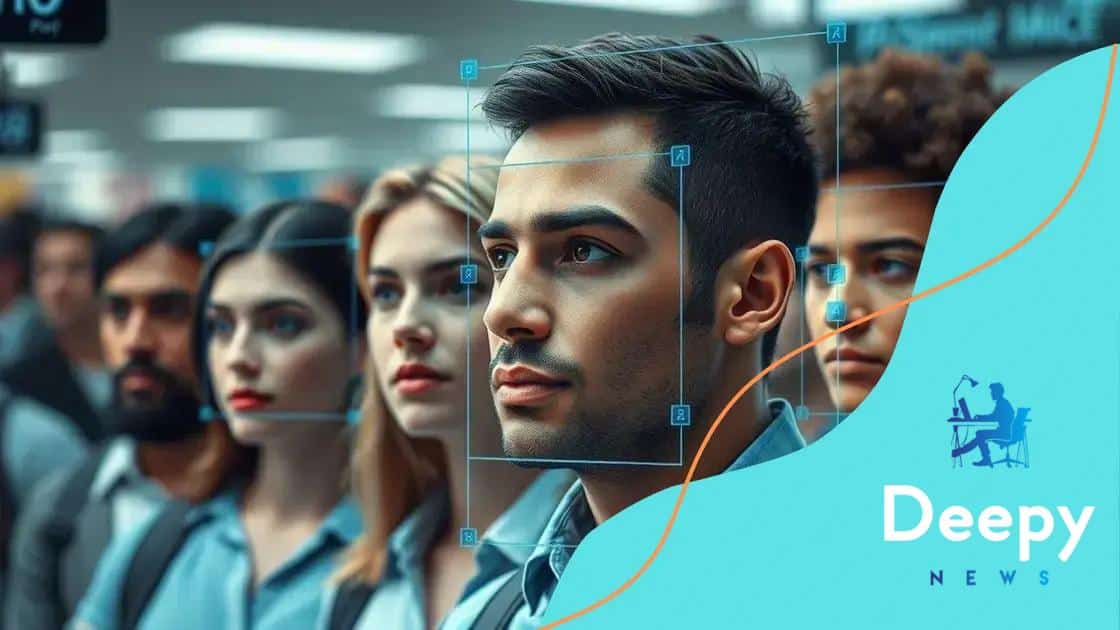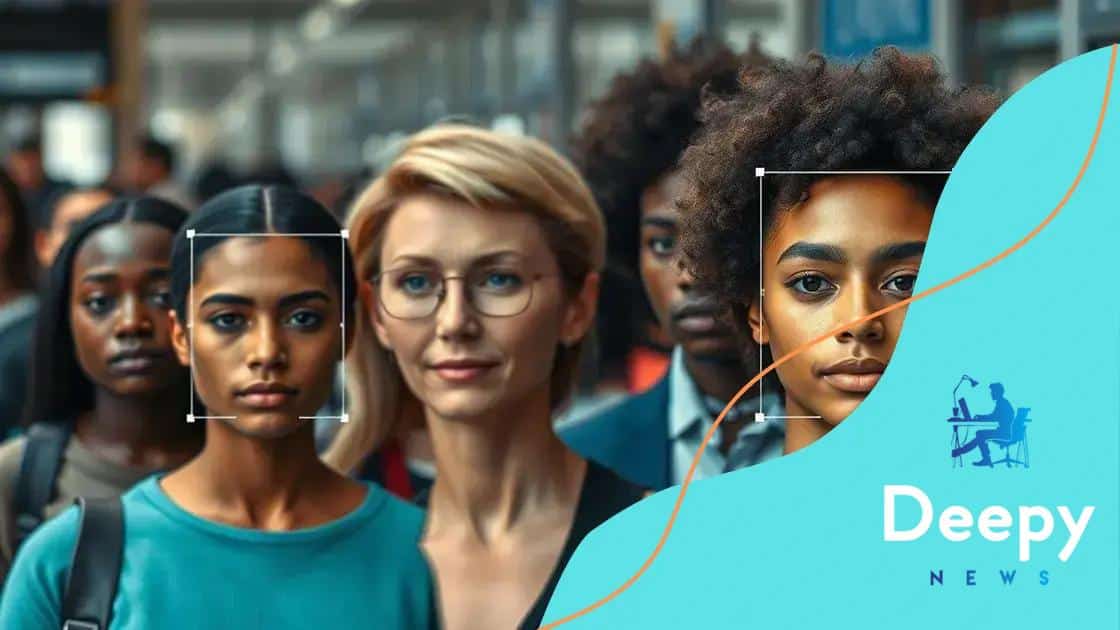Ethical challenges in using facial recognition technology

Ethical challenges in using facial recognition technology include privacy concerns, bias, discrimination, and the need for clear legal frameworks to ensure responsible usage and public trust.
Ethical challenges in using facial recognition technology are becoming a hot topic as we navigate a digital world. Have you ever thought about how these technologies affect your privacy? Let’s explore the implications together.
Understanding facial recognition technology
Understanding facial recognition technology is essential as it becomes more prevalent in our daily lives. This technology allows computers to identify and verify individuals by analyzing facial features. With its growing use in various sectors, including security, retail, and social media, grasping its functionality is vital to recognize its impact.
The process begins with capturing an image of a face, either from a live feed or a static photo. The system then detects facial features, such as the distance between the eyes, the shape of the jawline, and the contours of the cheeks. This data is converted into a numerical format and stored in a database for comparison. When a new image is uploaded, the algorithm checks for matches against the stored data, allowing for identification or verification.
Key Components of Facial Recognition Technology
Several components play a key role in the effectiveness of facial recognition systems. Understanding these can help demystify how they work:
- Image Acquisition: Capturing a clear image is the first step.
- Face Detection: Locating the face within the image ensures the system focuses on relevant data.
- Feature Extraction: This involves analyzing facial features to create a unique profile.
- Matching: The system compares extracted features against stored profiles to find a match.
The technology’s accuracy significantly hinges on the quality of images fed into the system. Poor lighting, occlusions, and low resolution can lead to errors. Proper implementation can enhance security measures, but it also raises important questions about privacy and ethics.
Consider how this technology is implemented in different scenarios. For example, law enforcement agencies utilize facial recognition to identify suspects in a crowd, while stores track customer behavior to personalize marketing strategies. While the benefits are clear, understanding the underlying mechanisms helps illuminate potential drawbacks.
As we continue to explore the implications of this technology, it’s crucial to stay informed about its advancements and challenges. Engaging in discussions and seeking transparency from developers can help ensure that facial recognition technology is used responsibly.
Privacy concerns with facial recognition
Privacy concerns with facial recognition technology are at the forefront of discussions today. As this technology becomes widely adopted, many individuals worry about their privacy. The ability for systems to identify and track people raises significant ethical questions.
One primary issue is the potential for surveillance. With facial recognition, anyone can be monitored in public spaces, making it easy for organizations to collect data without consent. This lack of transparency often leads to fears of misuse. For instance, companies might use the data collected for targeted advertising, raising questions about consent.
Key Privacy Issues
Several specific concerns arise regarding privacy when using facial recognition technology:
- Informed Consent: Many individuals do not know their faces are being scanned.
- Data Security: Storing facial data can increase the risk of data breaches.
- Potential for Misuse: Data can be used for tracking individuals without their agreement.
- Discrimination: The technology may target specific groups disproportionately.
Another major concern is the accuracy of facial recognition systems. In many cases, these systems can struggle with identifying people accurately, especially those from diverse backgrounds. This inaccuracy can lead to false identifications and wrongful accusations, further eroding public trust.
Public backlash against facial recognition has been growing. Many cities and countries have enacted bans or regulations to control its use. Advocacy groups argue that privacy rights need to be protected in an age where technology evolves rapidly.
As technology continues to develop, the conversation surrounding facial recognition and privacy will remain critical. Engaging in open discussions about the implications and regulations will help ensure that this powerful technology is used responsibly and ethically.
Bias and discrimination issues

Bias and discrimination issues in facial recognition technology are critical concerns that need to be addressed. Many studies have shown that these systems can be biased against certain groups of people. This bias often stems from the data used to train the algorithms, which may not represent the entire population fairly.
For example, individuals with darker skin tones or women are frequently misidentified at higher rates compared to white males. Such discrepancies raise alarms about how facial recognition technology is employed in various sectors, including law enforcement and hiring practices.
Understanding the Factors Behind Bias
Several factors contribute to bias in facial recognition systems:
- Training Data: If the dataset lacks diversity, the system may struggle to identify faces accurately.
- Algorithm Design: The way algorithms are designed can unintentionally favor specific traits, leading to higher error rates for others.
- Implementation Practices: How and where technology is implemented can also affect its fairness and accuracy.
As facial recognition technology becomes more widely used, discussions about bias are increasingly important. Public backlash has led some companies and governments to reevaluate their use of these systems. It is essential to push for improvements that ensure fairness and accuracy for all individuals, regardless of their background.
To combat these issues, organizations must focus on developing fair algorithms. This includes using diverse training datasets and regularly auditing technology for biased outcomes. Additionally, promoting transparency and accountability in how facial recognition is used can help reduce discrimination.
Many advocates call for stricter regulations to manage the use of facial recognition technology. They argue that robust oversight is required to prevent systemic discrimination. Understanding these bias and discrimination issues can lead to a more equitable use of technology in society.
Legal implications of facial recognition
Legal implications of facial recognition technology are becoming increasingly complex as its use expands across various sectors. Many countries are grappling with how to regulate this technology properly to balance innovation and individual rights.
One primary concern is the lack of clear legal frameworks governing the use of facial recognition. In many regions, laws have not kept pace with technology, leading to a patchwork of regulations. This inconsistency can create confusion for businesses and individuals alike.
Key Legal Challenges
Several key legal challenges arise with the use of facial recognition technology:
- Data Protection: How is facial data collected, stored, and protected from unauthorized access?
- Consent: Are individuals aware their faces are being scanned, and have they given consent?
- Liability: Who is responsible when facial recognition leads to misidentification or harm?
- Regulation Compliance: How do companies ensure compliance with existing laws and regulations?
The implications extend beyond just privacy concerns. For instance, law enforcement agencies often use facial recognition to identify suspects. However, this practice raises questions about constitutional rights, such as the right to privacy and due process. There is ongoing debate about whether police should have unrestricted access to this technology.
Some jurisdictions have moved forward by creating stringent regulations on facial recognition technology. For example, certain cities have implemented bans on its use by law enforcement, citing civil liberties concerns. These measures aim to protect individuals from potential abuse and overreach.
As more communities begin to engage in discussions about the legal implications of facial recognition technology, it is crucial for stakeholders—including lawmakers, technology developers, and civil rights advocates—to work together. Establishing clear guidelines and standards will be essential to ensure that technological advancements do not infringe on essential human rights.
Future of ethical practices in technology
The future of ethical practices in technology is a crucial topic as we continue to integrate advanced systems into our daily lives. As technologies like facial recognition become more common, there is a growing need to prioritize ethics within development and deployment.
With the increasing power of technology comes the responsibility to use it wisely. Companies and developers must focus on transparency, accountability, and fairness. Public trust can only be maintained when ethical standards are upheld.
Key Aspects of Ethical Technology
Several essential aspects shape the future of ethical practices in technology:
- Transparency: Companies should openly share how their technologies work and how data is used.
- Bias Mitigation: It’s vital to continuously test and improve systems to minimize biased outcomes.
- User Consent: Organizations must ensure users clearly understand how their data will be used and provide explicit consent.
- Regulatory Compliance: Abiding by laws and ethical guidelines creates a framework for responsible technology use.
As society continues to evolve, conversations around ethics in technology will expand. Consumers are becoming more aware and vocal about their rights, prompting companies to reconsider their practices. This pressure can lead to more significant changes that favor ethical frameworks.
One avenue for fostering ethical practices is through education in technology fields. By instilling a strong ethical foundation in future developers and engineers, we can nurture a culture that values responsibility alongside innovation. Additionally, collaborations between tech firms and ethicists can contribute to developing best practices.
Organizations are encouraged to establish ethics boards to guide decision-making. These boards can review new technologies before implementation, identifying potential ethical concerns early in the process. As a result, technology can be used in ways that enhance society rather than harm it.
FAQ – Frequently Asked Questions about Ethical Practices in Technology
What are ethical practices in technology?
Ethical practices in technology involve prioritizing fairness, transparency, and privacy when developing and deploying technology like facial recognition systems.
Why is transparency important in technology use?
Transparency builds trust between users and organizations. When companies openly share how technologies work and how data is used, it fosters a responsible tech environment.
How can education improve ethics in tech?
By teaching ethical standards in technology fields, future developers become aware of their responsibilities, leading to more thoughtful and equitable practices.
What role does collaboration play in ethical technology?
Collaboration among tech developers, ethicists, and communities helps create solutions that address ethical concerns effectively, ensuring technology benefits everyone.






